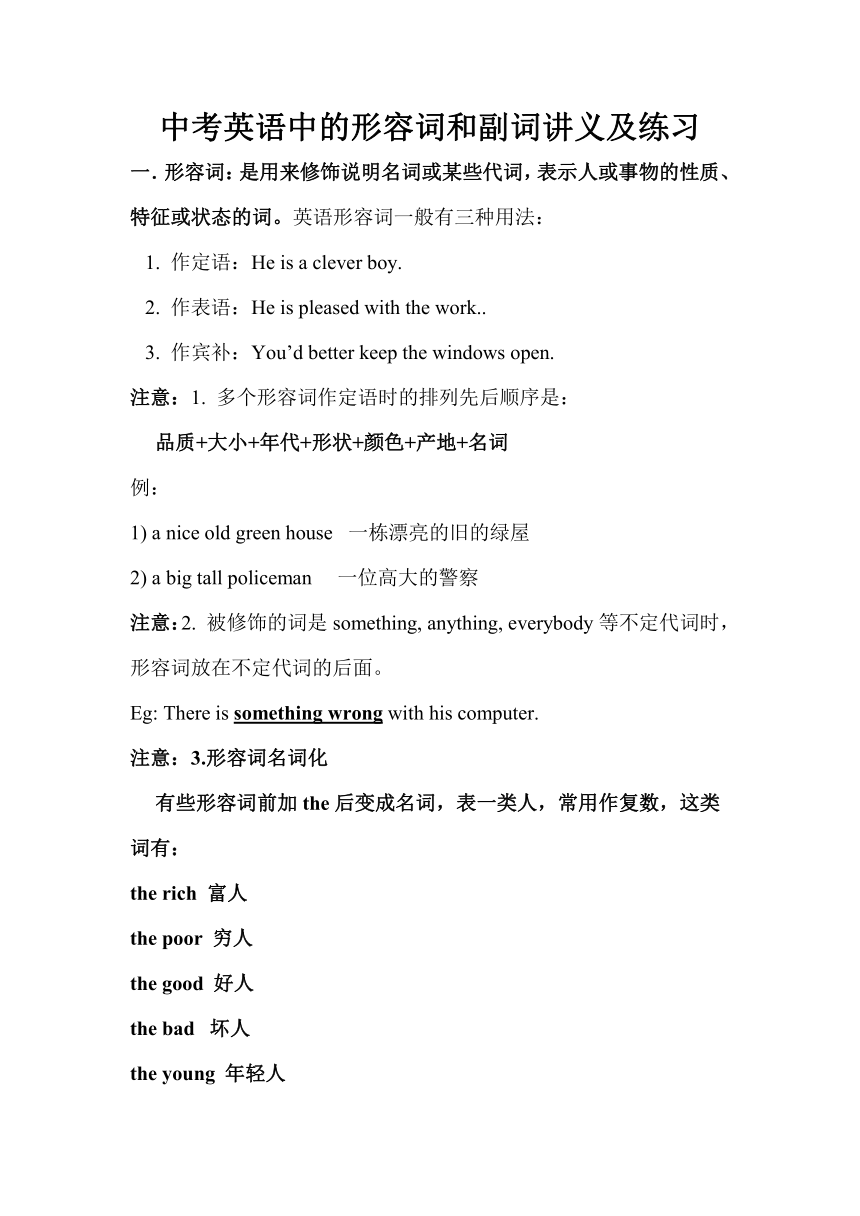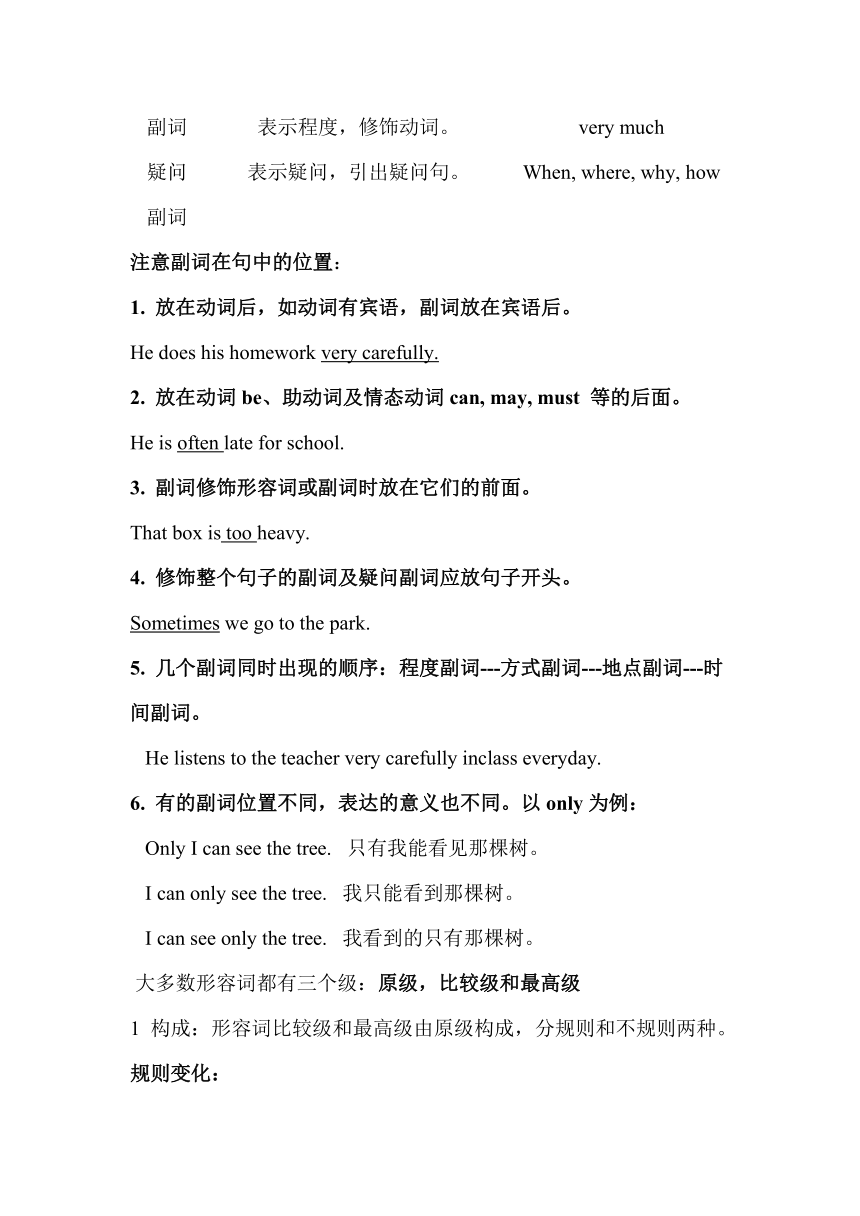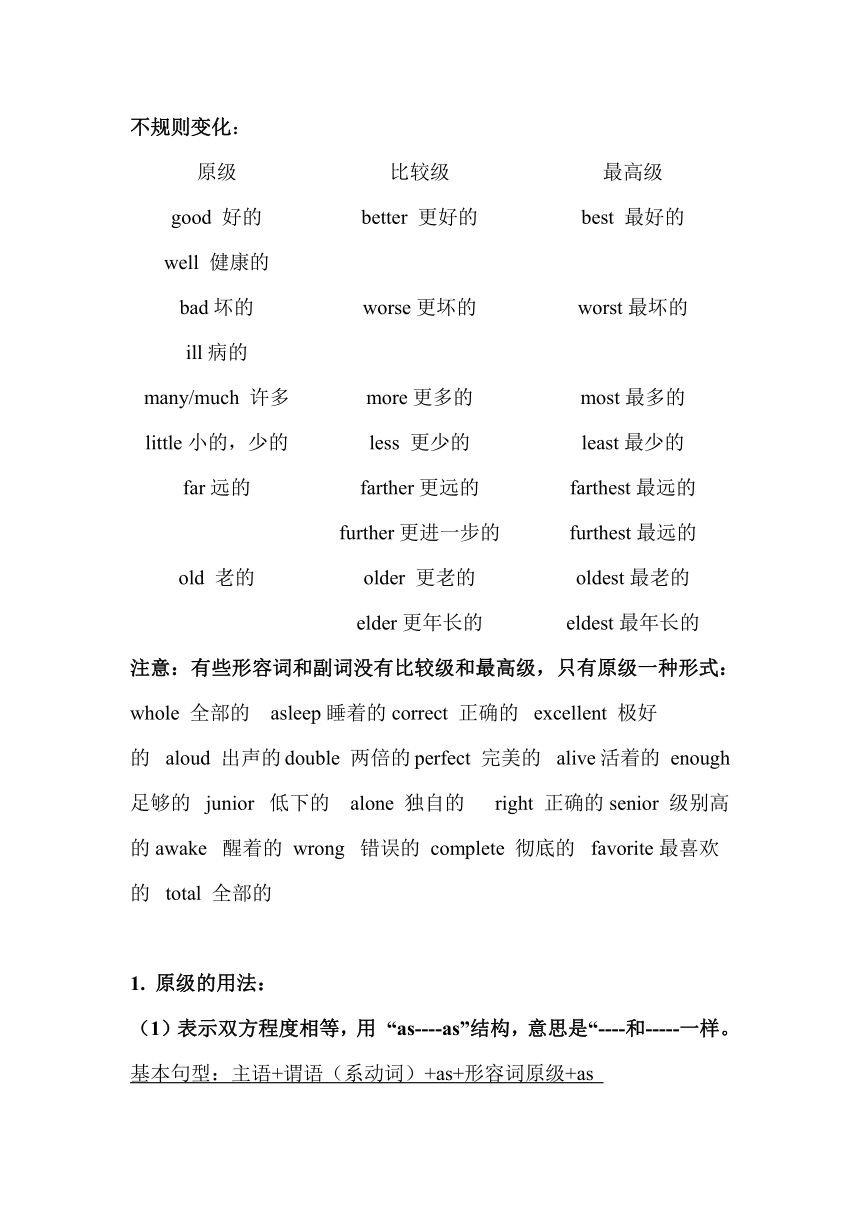中考英语形容词和副词讲义及练习(含答案)
文档属性
| 名称 | 中考英语形容词和副词讲义及练习(含答案) |

|
|
| 格式 | docx | ||
| 文件大小 | 25.9KB | ||
| 资源类型 | 教案 | ||
| 版本资源 | 通用版 | ||
| 科目 | 英语 | ||
| 更新时间 | 2024-09-29 15:51:56 | ||
图片预览





文档简介
中考英语中的形容词和副词讲义及练习
一.形容词:是用来修饰说明名词或某些代词,表示人或事物的性质、特征或状态的词。英语形容词一般有三种用法:
1. 作定语:He is a clever boy.
2. 作表语:He is pleased with the work..
3. 作宾补:You’d better keep the windows open.
注意:1. 多个形容词作定语时的排列先后顺序是:
品质+大小+年代+形状+颜色+产地+名词
例:
1) a nice old green house 一栋漂亮的旧的绿屋
2) a big tall policeman 一位高大的警察
注意:2. 被修饰的词是something, anything, everybody等不定代词时,形容词放在不定代词的后面。
Eg: There is something wrong with his computer.
注意:3.形容词名词化
有些形容词前加the后变成名词,表一类人,常用作复数,这类词有:
the rich 富人
the poor 穷人
the good 好人
the bad 坏人
the young 年轻人
the old 老年人
the living 活人
the dead 死人
the blind 盲人
the deaf 聋哑人
Eg : The young should take good care of the old.
二.副词:用以修饰动词,形容词,其它副词或整个句子的词,在句中作状语。
类别 用法 例词
时间 副词 表示时间, 修饰动词。 now,then, tomorrow
表示频度, 修饰动词。 sometimes, often, usually
表示其它, 修饰动词。 early, late, soon
地点 副词 表示地点, 修饰动词。 here, there, home
表示位置, 修饰动词。 up, down, out, in, back
方式 副词 表示方式,修饰动词及其它。 well, hard, carefully
程度 副词 表程度,修饰形容词副词。 too, very, not, much
表示程度,修饰动词。 very much
疑问 副词 表示疑问,引出疑问句。 When, where, why, how
注意副词在句中的位置:
放在动词后,如动词有宾语,副词放在宾语后。
He does his homework very carefully.
2. 放在动词be、助动词及情态动词can, may, must 等的后面。
He is often late for school.
3. 副词修饰形容词或副词时放在它们的前面。
That box is too heavy.
4. 修饰整个句子的副词及疑问副词应放句子开头。
Sometimes we go to the park.
5. 几个副词同时出现的顺序:程度副词---方式副词---地点副词---时间副词。
He listens to the teacher very carefully inclass everyday.
6. 有的副词位置不同,表达的意义也不同。以only为例:
Only I can see the tree. 只有我能看见那棵树。
I can only see the tree. 我只能看到那棵树。
I can see only the tree. 我看到的只有那棵树。
大多数形容词都有三个级:原级,比较级和最高级
1 构成:形容词比较级和最高级由原级构成,分规则和不规则两种。
规则变化:
构成方法 原级 比较级 最高级
单音节词和少数双音节词 1.一般在词尾加er或est tall long clever taller longer cleverer tallest longest cleverest
2以字母e结尾的加r,st nice fine late nicer finer later nicest finest latest
3以重读闭音节结尾的,如末尾只有一个辅音字母应双写这一字母,再加er或est big hot thin bigger hotter thinner biggest hottest thinnest
4以辅音字母+y结尾的,变y为i,再加er, est early easy happy earlier easier happier earliest easiest happiest
多音节词 在词前加more变成比较级,加most变成最高级。 beautiful More beautiful Most beautiful
careful more careful most careful
carefully more carefully most carefully
quickly more quickly most quickly
不规则变化:
原级 比较级 最高级
good 好的 well 健康的 better 更好的 best 最好的
bad坏的 ill病的 worse更坏的 worst最坏的
many/much 许多 more更多的 most最多的
little小的,少的 less 更少的 least最少的
far远的 farther更远的 further更进一步的 farthest最远的 furthest最远的
old 老的 older 更老的 elder更年长的 oldest最老的 eldest最年长的
注意:有些形容词和副词没有比较级和最高级,只有原级一种形式:
whole 全部的 asleep睡着的 correct 正确的 excellent 极好的 aloud 出声的double 两倍的perfect 完美的 alive活着的 enough 足够的 junior 低下的 alone 独自的 right 正确的senior 级别高的awake 醒着的 wrong 错误的 complete 彻底的 favorite最喜欢的 total 全部的
1. 原级的用法:
(1)表示双方程度相等,用 “as----as”结构,意思是“----和-----一样。
基本句型:主语+谓语(系动词)+as+形容词原级+as
Eg: Jack is as tall as his brother.杰克和他哥哥一样高。
(2)表示双方程度不相等,用 “not so(as) ---as”结构。意思是“---和----不一样”。
基本句型:主语+谓语(系动词)+not so(as)+形容词原级+as
Eg: Jack is not so (as) tall as his brother.
2.比较级的用法。
(1)表示两个人或事物进行比较时,用比较级。
基本句型:主语+谓语(系动词)+形容词比较级+than+对比成分 Jack is taller than his brother.
(2)比较级+and+比较级,表示越来越------的意思。
Summer is coming, it is getting hotter and hotter.
(3)可用“the+比较级+the+比较级,表示越----,就越---的意思。
The busier I am, the happier I feel.我越忙,越高兴。
(4)表语中比较两个形容词时,不管形容词有多少音节,都用 “more---than---结构,译为 “是---而不是”或“与其说是----不如说是---”
He is more clever than honest. 与其说他诚实,不如说他聪明。
(5)在形容词比较级前可用much, a lot, a little, a bit, rather, far,even, still, yet, any, no---等副词,表示程度。
The sun is much bigger than the earth.
(6)当句中出现 of the two---时,应用the +比较级
This ruler is the longer of the two rulers.
(7)no+比较级+than:和---一样不---
This book is no better than that one.这本书和那本书一样不好。
not+比较级+than不象---那样---
This book is not better than that one. 这本书不及那本书好。
(8)基数词+times比较级+than 是---的---多少倍。
This room is 3 times larger than that one
the+名词+of the size of
这房间是那房间的3倍大。
3.最高级的用法。
(1)三个或三个以上的人或事物进行比较时,用最高级。
基本句型:主语+谓语(系动词)+the+形容词最高级+名词+表示范围的短语或从句。(常见的介词短语有:in, of, among---)
Mike is the tallest in our class.
She is the eldest among the three sisters.
This book is the most difficult that I have ever read.
( 2 ) 形容词最高级可以被序数词修饰。
The Yellow River is the second longest in China.
中考专项练习:
练习一:写出下列形容词、副词的比较级和最高级形式。
1. clean_______ ________
2. long _______ _________
3. small ________ __________
4. early_______ _________
5. busy________ ________
6. heavy _______ __________
7. nice ________ _________
8. late________ __________
9. little_________ _______
10. hot ________ _________
11. big ________ __________
12. thin________ __________
13. bad________ ________
14. well _______ __________
15. cool ________ _________
16.slowly ________ ________
17. important ___________ ___________
18. carefully________________________
19. fast ________ _________
20. hard________ ________
练习二.选择填空。
( )1. Is Nick a ______ student
--- Yes. And he can speak Chinese______.
A. good, well B. good, good
C. well, good D. well, well
( )2. That apple is ____ high. I can’t get it.
A. much B. very much
C. too D. very too
( )3. They aren’t classmates, but they go to______ school.
A. different B. a different
C. the same D. same
( )4. Now let’s go____.
A. the classroom B. the factory
C. to home D. home
( )5. What’s five plus two
--- It’s seven.---That’s ____.
A.well B. right C. wrong D. yes
( )6. The purple blouse is _____ the yellow one.
A.as cheap as B. so cheap as
C. as cheaper as D. much cheap than
( )7. These shoes are much too _____ for me.
A. big B. bigger
C. biggest D. the biggest
( )8. It was ____ yesterday than today.
A.much hot B. more hotter
C. the hottest D. hotter
( )9. In my family, my father gets up _____.
A. early B. earlier
C. very early D. earliest
( )10. This box is ____ that one.
A. heavy than B. as heavy as C. heavier as
中考专项练习答案:
练习一:
cleaner, cleanest
longer, longest
smaller, smallest
earlier, earliest
busier, busiest
heavier, heaviest
nicer, nicest
later, latest
less, least
10. hotter, hottest
11. bigger, biggest
12. thinner, thinnest
13. worse, worst
14. better, best
15. cooler, coolest
16. more slowly, most slowly
17. more important, the most important
18. more carefully, the most carefully
19. faster, fastest
20. harder, hardest
练习二:
1.A 2. C3. C4. D5.B 6. A7. A8. D9.D 10. B
一.形容词:是用来修饰说明名词或某些代词,表示人或事物的性质、特征或状态的词。英语形容词一般有三种用法:
1. 作定语:He is a clever boy.
2. 作表语:He is pleased with the work..
3. 作宾补:You’d better keep the windows open.
注意:1. 多个形容词作定语时的排列先后顺序是:
品质+大小+年代+形状+颜色+产地+名词
例:
1) a nice old green house 一栋漂亮的旧的绿屋
2) a big tall policeman 一位高大的警察
注意:2. 被修饰的词是something, anything, everybody等不定代词时,形容词放在不定代词的后面。
Eg: There is something wrong with his computer.
注意:3.形容词名词化
有些形容词前加the后变成名词,表一类人,常用作复数,这类词有:
the rich 富人
the poor 穷人
the good 好人
the bad 坏人
the young 年轻人
the old 老年人
the living 活人
the dead 死人
the blind 盲人
the deaf 聋哑人
Eg : The young should take good care of the old.
二.副词:用以修饰动词,形容词,其它副词或整个句子的词,在句中作状语。
类别 用法 例词
时间 副词 表示时间, 修饰动词。 now,then, tomorrow
表示频度, 修饰动词。 sometimes, often, usually
表示其它, 修饰动词。 early, late, soon
地点 副词 表示地点, 修饰动词。 here, there, home
表示位置, 修饰动词。 up, down, out, in, back
方式 副词 表示方式,修饰动词及其它。 well, hard, carefully
程度 副词 表程度,修饰形容词副词。 too, very, not, much
表示程度,修饰动词。 very much
疑问 副词 表示疑问,引出疑问句。 When, where, why, how
注意副词在句中的位置:
放在动词后,如动词有宾语,副词放在宾语后。
He does his homework very carefully.
2. 放在动词be、助动词及情态动词can, may, must 等的后面。
He is often late for school.
3. 副词修饰形容词或副词时放在它们的前面。
That box is too heavy.
4. 修饰整个句子的副词及疑问副词应放句子开头。
Sometimes we go to the park.
5. 几个副词同时出现的顺序:程度副词---方式副词---地点副词---时间副词。
He listens to the teacher very carefully inclass everyday.
6. 有的副词位置不同,表达的意义也不同。以only为例:
Only I can see the tree. 只有我能看见那棵树。
I can only see the tree. 我只能看到那棵树。
I can see only the tree. 我看到的只有那棵树。
大多数形容词都有三个级:原级,比较级和最高级
1 构成:形容词比较级和最高级由原级构成,分规则和不规则两种。
规则变化:
构成方法 原级 比较级 最高级
单音节词和少数双音节词 1.一般在词尾加er或est tall long clever taller longer cleverer tallest longest cleverest
2以字母e结尾的加r,st nice fine late nicer finer later nicest finest latest
3以重读闭音节结尾的,如末尾只有一个辅音字母应双写这一字母,再加er或est big hot thin bigger hotter thinner biggest hottest thinnest
4以辅音字母+y结尾的,变y为i,再加er, est early easy happy earlier easier happier earliest easiest happiest
多音节词 在词前加more变成比较级,加most变成最高级。 beautiful More beautiful Most beautiful
careful more careful most careful
carefully more carefully most carefully
quickly more quickly most quickly
不规则变化:
原级 比较级 最高级
good 好的 well 健康的 better 更好的 best 最好的
bad坏的 ill病的 worse更坏的 worst最坏的
many/much 许多 more更多的 most最多的
little小的,少的 less 更少的 least最少的
far远的 farther更远的 further更进一步的 farthest最远的 furthest最远的
old 老的 older 更老的 elder更年长的 oldest最老的 eldest最年长的
注意:有些形容词和副词没有比较级和最高级,只有原级一种形式:
whole 全部的 asleep睡着的 correct 正确的 excellent 极好的 aloud 出声的double 两倍的perfect 完美的 alive活着的 enough 足够的 junior 低下的 alone 独自的 right 正确的senior 级别高的awake 醒着的 wrong 错误的 complete 彻底的 favorite最喜欢的 total 全部的
1. 原级的用法:
(1)表示双方程度相等,用 “as----as”结构,意思是“----和-----一样。
基本句型:主语+谓语(系动词)+as+形容词原级+as
Eg: Jack is as tall as his brother.杰克和他哥哥一样高。
(2)表示双方程度不相等,用 “not so(as) ---as”结构。意思是“---和----不一样”。
基本句型:主语+谓语(系动词)+not so(as)+形容词原级+as
Eg: Jack is not so (as) tall as his brother.
2.比较级的用法。
(1)表示两个人或事物进行比较时,用比较级。
基本句型:主语+谓语(系动词)+形容词比较级+than+对比成分 Jack is taller than his brother.
(2)比较级+and+比较级,表示越来越------的意思。
Summer is coming, it is getting hotter and hotter.
(3)可用“the+比较级+the+比较级,表示越----,就越---的意思。
The busier I am, the happier I feel.我越忙,越高兴。
(4)表语中比较两个形容词时,不管形容词有多少音节,都用 “more---than---结构,译为 “是---而不是”或“与其说是----不如说是---”
He is more clever than honest. 与其说他诚实,不如说他聪明。
(5)在形容词比较级前可用much, a lot, a little, a bit, rather, far,even, still, yet, any, no---等副词,表示程度。
The sun is much bigger than the earth.
(6)当句中出现 of the two---时,应用the +比较级
This ruler is the longer of the two rulers.
(7)no+比较级+than:和---一样不---
This book is no better than that one.这本书和那本书一样不好。
not+比较级+than不象---那样---
This book is not better than that one. 这本书不及那本书好。
(8)基数词+times比较级+than 是---的---多少倍。
This room is 3 times larger than that one
the+名词+of the size of
这房间是那房间的3倍大。
3.最高级的用法。
(1)三个或三个以上的人或事物进行比较时,用最高级。
基本句型:主语+谓语(系动词)+the+形容词最高级+名词+表示范围的短语或从句。(常见的介词短语有:in, of, among---)
Mike is the tallest in our class.
She is the eldest among the three sisters.
This book is the most difficult that I have ever read.
( 2 ) 形容词最高级可以被序数词修饰。
The Yellow River is the second longest in China.
中考专项练习:
练习一:写出下列形容词、副词的比较级和最高级形式。
1. clean_______ ________
2. long _______ _________
3. small ________ __________
4. early_______ _________
5. busy________ ________
6. heavy _______ __________
7. nice ________ _________
8. late________ __________
9. little_________ _______
10. hot ________ _________
11. big ________ __________
12. thin________ __________
13. bad________ ________
14. well _______ __________
15. cool ________ _________
16.slowly ________ ________
17. important ___________ ___________
18. carefully________________________
19. fast ________ _________
20. hard________ ________
练习二.选择填空。
( )1. Is Nick a ______ student
--- Yes. And he can speak Chinese______.
A. good, well B. good, good
C. well, good D. well, well
( )2. That apple is ____ high. I can’t get it.
A. much B. very much
C. too D. very too
( )3. They aren’t classmates, but they go to______ school.
A. different B. a different
C. the same D. same
( )4. Now let’s go____.
A. the classroom B. the factory
C. to home D. home
( )5. What’s five plus two
--- It’s seven.---That’s ____.
A.well B. right C. wrong D. yes
( )6. The purple blouse is _____ the yellow one.
A.as cheap as B. so cheap as
C. as cheaper as D. much cheap than
( )7. These shoes are much too _____ for me.
A. big B. bigger
C. biggest D. the biggest
( )8. It was ____ yesterday than today.
A.much hot B. more hotter
C. the hottest D. hotter
( )9. In my family, my father gets up _____.
A. early B. earlier
C. very early D. earliest
( )10. This box is ____ that one.
A. heavy than B. as heavy as C. heavier as
中考专项练习答案:
练习一:
cleaner, cleanest
longer, longest
smaller, smallest
earlier, earliest
busier, busiest
heavier, heaviest
nicer, nicest
later, latest
less, least
10. hotter, hottest
11. bigger, biggest
12. thinner, thinnest
13. worse, worst
14. better, best
15. cooler, coolest
16. more slowly, most slowly
17. more important, the most important
18. more carefully, the most carefully
19. faster, fastest
20. harder, hardest
练习二:
1.A 2. C3. C4. D5.B 6. A7. A8. D9.D 10. B
